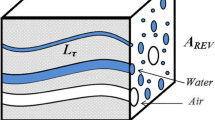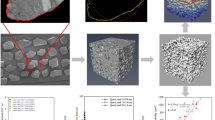Abstract
Pore network analysis is used to investigate the effects of microscopic parameters of the pore structure such as pore geometry, pore-size distribution, pore space topology and fractal roughness porosity on resistivity index curves of strongly water-wet porous media. The pore structure is represented by a three-dimensional network of lamellar capillary tubes with fractal roughness features along their pore-walls. Oil-water drainage (conventional porous plate method) is simulated with a bond percolation-and-fractal roughness model without trapping of wetting fluid. The resistivity index, saturation exponent and capillary pressure are expressed as approximate functions of the pore network parameters by adopting some simplifying assumptions and using effective medium approximation, universal scaling laws of percolation theory and fractal geometry. Some new phenomenological models of resistivity index curves of porous media are derived. Finally, the eventual changes of resistivity index caused by the permanent entrapment of wetting fluid in the pore network are also studied.
Resistivity index and saturation exponent are decreasing functions of the degree of correlation between pore volume and pore size as well as the width of the pore size distribution, whereas they are independent on the mean pore size. At low water saturations, the saturation exponent decreases or increases for pore systems of low or high fractal roughness porosity respectively, and obtains finite values only when the wetting fluid is not trapped in the pore network. The dependence of saturation exponent on water saturation weakens for strong correlation between pore volume and pore size, high network connectivity, medium pore-wall roughness porosity and medium width of the pore size distribution. The resistivity index can be described succesfully by generalized 3-parameter power functions of water saturation where the parameter values are related closely with the geometrical, topological and fractal properties of the pore structure.
Similar content being viewed by others
References
Anderson, W. G.: 1986a, Wettability literature survey-Part 1: Rock/oil/brine interactions and the effects of core handling on wettability, J. Pet. Tech., October, 1125-1144.
Anderson, W. G.: 1986b, Wettability literature survey-Part 2: Wettability measurement, J. Pet. Tech., November, 1246-1262.
Anderson, W. G.: 1986c, Wettability literature survey-Part 3: The effects of wettability on the electrical properties of porous media, J. Pet. Tech., December, 1371-1378.
Archie, G. E.: 1942, The electrical resistivity log as an aid in determining some reservoir characteristics, Trans. AIME 146, 54-62.
Bard, Y.: 1974, Non-linear Parameter Estimation, Academic Press, New York.
Benson, A. K., Payne, K. L. and Stubben, M. A.: 1997, Mapping groundwater contamination using dc resistivity and VLF geophysical methods-a case study, Geophysics 62, 80-86.
Blunt, M., King, M. J. and Scher, H.: 1992, Simulation and theory of two-phase flow in porous media, Phys. Rev. A 46, 7680-7699.
Broadbent, S. R. and Hammersley, J. M.: 1957, Percolation processes: I. Crystals and mazes, Proc. Camb. Phil. Soc. 53, 629-641.
Chandler, R., Koplik, J., Lerman, K. and Willemsen, J. F.: 1982, Capillary displacement and percolation in porous media, J. Fluid Mech. 119, 249-267.
Chatzis, I. and Dullien, F. A. L.: 1977, Modelling pore structure by 2-D and 3-D networks with application to sandstones, J. Can. Pet. Tech. 16, 97-108.
Constantinides, G. N. and Payatakes, A. C.: 1996, Network simulation of steady-state twophase flow in consolidated porous media, AIChE J. 42, 369-382.
deWaal, J. A., Smits, R. M. M., de Graaf, J. D., and Schipper, B. A.: 1991, Measurement and evaluation of resistivity index curves, Log Analyst 32, 583-595.
Dias, M. M. and Payatakes, A. C.: 1986, Network models for two-phase flow in porous media: Part 1. Immiscible microdisplacement of non-wetting fluids, J. Fluid Mech. 164, 305-336.
Diaz, C. E., Chatzis, I. and Dullien, F. A. L.: 1987, Simulation of capillary pressure curves using bond-correlated site percolation on a simple cubic network, Transport in Porous Media 2, 215-240.
Dicker, A. I. M. and Bemelans, W. A.: 1984, Models for simulating the electrical resistance in porous media, 25th SPWLA Ann. Logg. Symp., New Orleans.
Diederix, K. M.: 1982, Anomalous relationships between resistivity index and water saturations in the Rotliegend sandstone (The Netherlands), 23rd SPWLA Ann. Logg. Symp., Corpus Christi, Texas.
Dullien, F. A. L. and Dhawan, G. K.: 1974, Characterization of pore structure by a combination of quantitative photomicrography and mercury porosimetry, J. Colloid Interface Sci. 47, 337-349.
Dullien, F. A. L., Lai, Y. and MacDonald, I. F.: 1986, Hydraulic continuity of residual wetting phase in porous media, J. Colloid Interface Sci. 109, 201-218.
Dullien, F. A. L., Zarconne, C., MacDonald, I. F., Collins, A. and Bochard, D. E.: 1989, The effects of surface roughness on the capillary pressure curves and the heights of capillary rise in glass beadpacks, J. Colloid Interface Sci. 127, 362-372.
Dullien, F. A. L.: 1992, Porous Media: Fluid Transport and Pore Structure, Academic Press, San Diego, California.
Frisch, H. L. and Hammersley, J. M.: 1963, Percolation processes and related topics, J. Soc. Ind. Appl. Math. 11, 894-918.
Givens, W. W.: 1987, A conductive rock matrix model for the analysis of low-contrast resistivity formations, Log Analyst 28, 138-151.
Hansen, J. P. and Skjeltorp, A. T.: 1988, Fractal pore space and rock permeability implications, Phys. Rev. B 38, 2635-2638.
Heiba, A. A., Davis, H. T. and Scriven, L. E.: 1983, Effect of wettability on two-phase relative permeabilities and capillary pressures, Paper SPE 12172, 58th Ann. Tech. Conf. SPE, San Francisco, California.
Heiba, A. A., Sahimi, M., Davis, H.T. and Scriven, L. E.: 1992, Percolation theory of two-phase relative permeability, SPERE 7, 123-132.
Herrick, D. C.: 1988, Conductivity models, pore geometry and conduction mechanisms, 29th SPWLA Ann. Logg. Symp., San Antonio, Texas.
Herrick, D. C. and Kennedy, W. D.: 1993, Electrical efficiency: a pore geometric model for the electrical properties of rocks, 34th SPWLA Ann. Logg. Symp., Calgary, Alberta.
Ioannides, M. A. and Chatzis, I.: 1993, Network modelling of pore structure and transport properties of porous media, Chem. Engng. Sci. 48, 951-972.
Ioannides, M. A., Chatzis, I. and Sudicky, E. A.: 1993, The effect of spatial correlations on the accessibility characteristics of three-dimensional cubic networks, Water Resour. Res. 29, 1777-1785.
Jerauld, G. R. and Salter, S. J.: 1990, The effect of pore structure on hysteressis in relative permeability and capillary pressure: Pore-level modeling, Transport in Porous Media 5, 103-151.
Kirkpatrick, S.: 1973, Percolation and conduction, Rev. Mod. Phys. 45, 574-588.
Krohn, C. E. and Thompson, A. H.: 1986, Fractal sandstone pores: automated measurements using scanning electron microscope images, Phys. Rev. B 33, 6366-6374.
Krohn, C. E.: 1988a, Sandstone fractal and Euclidean pore volume distributions, J. Geophys. Res. 93(B4), 3286-3296.
Krohn, C. E.: 1988b, Fractal measurements of sandstones, shales and carbonates, J. Geophys. xRes. 93(B4), 3297-3305.
Larson, R. G., Scriven, L. E. and Davis, H. T.: 1977, Percolation theory of residual phases in porous media, Nature 268, 409-413.
Lenormand, R. and Bories, S.: 1980, Description d'un mécanisme de connexion de liaisons destinè àl'étude du drainage avec piegeage en milieu poreux, C.R. Acad. Sci. Paris B 291, 279-293.
Levine, S. and Cuthiell, D. L.: 1986, Relative permeabilities in two-phase flow through porous media: an application of effective medium theory, J. Can. Pet. Tech. 25, 74-84.
Mandelbrot, B. B.: 1983, The Fractal Geometry of Nature, Freeman, San Francisco.
Melrose, J. C.: 1990, Valid capillary pressure data at low wetting-phase saturations, SPERE, February, 95-99.
Morrow, N. R.: 1976, Capillary pressure correlations for uniformly wetted porous media, J. Can. Pet. Tech. 15, 49-69.
Morrow, N. R.: 1990, Wettability and its effects on oil recovery, J. Pet. Tech., December, 1476-1484.
Morrow, N. R. and Melrose, J. C.: 1991, Application of capillary pressure measurements to the determination of connate water saturation, In: N. R. Morrow (ed.), Interfacial Phenomena in Petroleum Recovery, Surfactant Science Series 36, Marcel Dekker.
Mualem, L. and Friedman, S. P.: 1991, Theoretical prediction of electrical conductivity in saturated and unsaturated soil, Water Resour. Res. 27, 2771-2777.
Pape, H., Riepe, L. and Schopper, J. R.: 1982, A pigeon hole model for relating permeability to specific surface, Log Analyst 25, 5-13.
Payatakes, A. C. and Dias, M. M.: 1984, Immiscible microdisplacement and ganglion dynamics in porous media, Rev. Chem. Engng. 2, 85-174.
Rasmus, J. C.: 1987, Asummary of the effects of various pore geometries and their wettabilities on measured and in situ values of cementation and saturation exponents, Log Analyst 28, 152-164.
Sahimi, M.: 1993, Flow phenomena in rocks: from continuum models to fractals, percolation, cellular automata and simulated annealing, Rev. Mod. Phys. 65, 1393-1534.
Sharma, M. M., Garough, A. and Dunlap, H. F.: 1991, Effects of wettability, pore geometry and stress on electrical conduction in fluid saturated rocks, Log Analyst 32, 511-526.
Sprunt, E. S., Hensel, W. M. Jr., York, C. E. and Honarpour, M. M.: 1988, Compilation of electrical resistivity measurements performed by twenty-five laboratories, Log Analyst 29, 13-29.
Stauffer, D. and Aharony, A.: 1991, Introduction to Percolation Theory, Taylor & Francis, London.
Suman, R. J. and Knight, R. J.: 1997, Effects of pore structure and wettability on the electrical resistivity of partially saturated rocks-a network study, Geophysics 62, 1151-1162.
Swanson, B. F.: 1985, Microporosity in reservoir rocks. Its measurement and influence on electrical resistivity, Log Analyst 26, 42-52.
Toledo, P. G., Novy, R. A., Davis, H. T. and Scriven, L. E.: 1990, Hydraulic conductivity of porous media at low water content, Soil Sci. Soc. Am. J. 54, 673-679.
Toledo, P. G., Novy, R. A., Davis, H. T. and Scriven, L. E.: 1994, Capillary pressure, water relative permeability, electrical conductivity and capillary dispersion coefficient of fractal porous media at low wetting phase saturation, SPE Advanc.Tech. Ser. 2, 136-141.
Tsakiroglou, C. D. and Payatakes, A. C.: 1991, Effects of pore size correlations on mercury porosimetry curves, J. Colloid Interface Sci. 146, 479-494.
Tsakiroglou, C. D. and Payatakes, A. C.: 1993, Pore-wall roughness as a fractal surface and theoretical simulation of mercury intrusion/retraction in porous media, J. Colloid Interface Sci. 159, 287-301.
Tsakiroglou, C. D. and Payatakes, A. C.: 1997, Analysis of the topological and geometrical characteristics of the pore space of permeable solids using serial tomography, mercury porosimetry and theoretical simulation, In: B. McEnaney et al. (eds), Proc. Symp. COPS-IV, Bath, 15-18 Sept. 1996, Royal Society of Chemistry, London, pp. 205-213.
Tsakiroglou, C. D. and Fleury, M.: 1998, Resistivity index of fractional wettability porous media, J. Petrol. Sci. Engng. (in press).
Vizika, O. and Lenormand, R.: 1991, Flow by film of the wetting phase in a porous medium and its role on the gravity drainage process, IEA 12th Int. Workshop and Symp., Bath, United Kingdom.
Wang, Y. and Sharma, M. M.: 1988, A network model for the resistivity behavior of partially saturated rocks, 29th SPWLA Ann. Logg. Sympos., San Antonio, Texas.
Wardlaw, N. C., Li, Y. and Forbes, D.: 1987, Pore-throat size correlation from capillary pressure curves, Transport in Porous Media 2, 597-614.
Waxman, W. H. and Smits, L. J. M.: 1968, Electrical conductivities in oil-bearing shaly sands, Trans. AIME 243, 107-122.
Wilkinson, D.: 1986, Percolation effects in immiscible displacement, Phys. Rev. A 34, 1380-1391.
Worthington, P. F., Pallat, N. and Toussait-Jackson, J. E.: 1985, Influence of microporosity upon the evaluation of hydrocarbon saturation, paper SPE 14296, 60th Ann. Tech. Conf. SPE, Las Vegas, Nevada
Author information
Authors and Affiliations
Corresponding author
Rights and permissions
About this article
Cite this article
Tsakiroglou, C.D., Fleury, M. Pore Network Analysis of Resistivity Index for Water-Wet Porous Media. Transport in Porous Media 35, 89–128 (1999). https://doi.org/10.1023/A:1006586409963
Issue Date:
DOI: https://doi.org/10.1023/A:1006586409963




